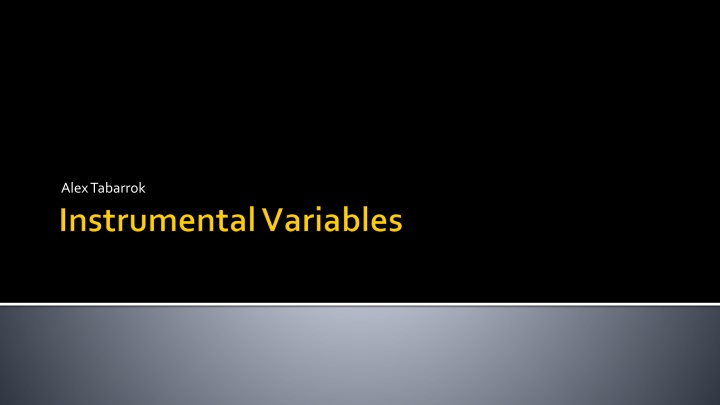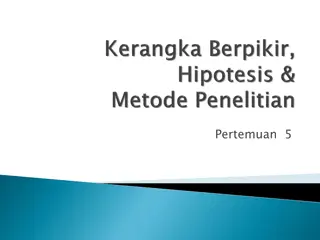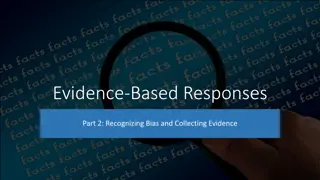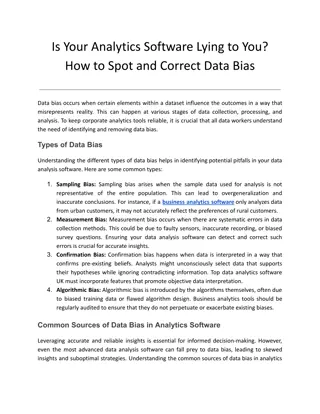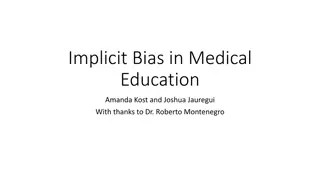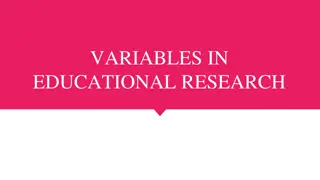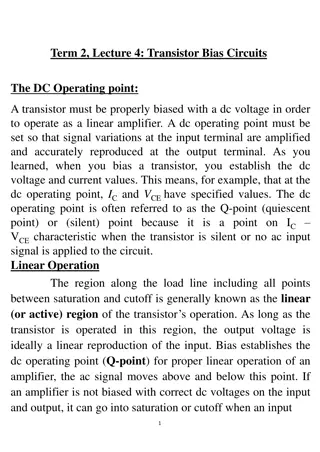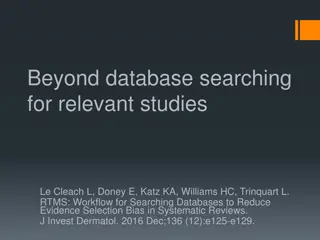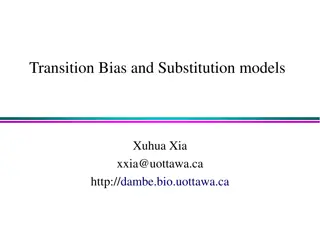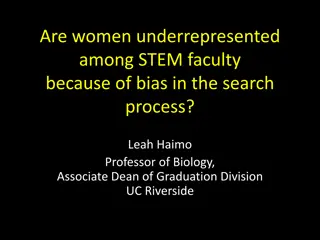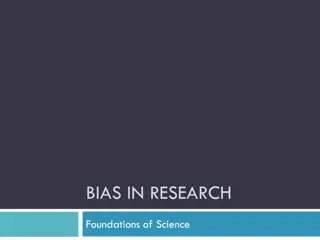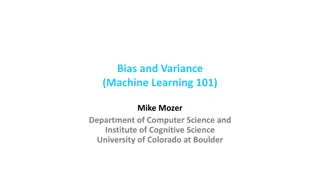Omitted Variables Bias
Omitted variable bias occurs when an important determinant of the outcome is left out of the analysis and is correlated with included variables, leading to biased estimates. Including the omitted variable or using instrumental variables can help mitigate this bias.
Download Presentation

Please find below an Image/Link to download the presentation.
The content on the website is provided AS IS for your information and personal use only. It may not be sold, licensed, or shared on other websites without obtaining consent from the author.If you encounter any issues during the download, it is possible that the publisher has removed the file from their server.
You are allowed to download the files provided on this website for personal or commercial use, subject to the condition that they are used lawfully. All files are the property of their respective owners.
The content on the website is provided AS IS for your information and personal use only. It may not be sold, licensed, or shared on other websites without obtaining consent from the author.
E N D
Presentation Transcript
Suppose the true model is: ? = ?0+ ?1?1+ ?2?2+ ?1 ? ??? ?(?1| ?1, ?2) = 0 But we estimate: ? = ?0+ ? ??? ?2 = ?2?2+ ?1 =?1? ?1 + ?2???(?1,?2) + ???(?1,?1) ?(?1) ???(?1,?2) ?(?1) ?1= ?1+?2 + 0 ?1?1+ ?2 Now consider the following regression. ?2= ?0+ ?1?1 Then by OLS: ?1=???(?1,Y) ?(?1) ?1=???(?1,?2) ?(?1) ?1=???(?1,?0+ ?1?1+ ?2?2+ ?1) ?(?1) ?1= ?1+?2?1
?1= ?1+?2?1 The OVB formula indicates that a) omitting a variable will cause bias if two things are true. The omitted variable is an important determinant of Y (?2) and the omitted variable is correlated with an included variable (?1). Note that the sign of the bias depends on the sign of ?2?1. E.g. Suppose that ?2> 0 & ?1< 0 then E.g. suppose wlog that ?1 ? . Note, however, that when ?1 ,?2 ??? ? and OLS will ascribe the total effect to ?1 so ?1 will be underestimated. Without further assumptions the formula holds only for case of one included and one excluded variable. Rule of thumb. ?1 will be biased downward.
Thus, an omitted variable will cause bias if it is an important determinant of Y and it is correlated with an included variable. What to do? Include the omitted variable! What about if we don t have the omitted variable and don t even know what it might be? Surprisingly, there is a solution.
Ideally we would control X randomly and run a trial. E.g. ideally we would like to determine education randomly and then find the effect of education variation on earnings. Experiments are expensive and not always possible. One approach is to look for natural experiments. A second related approach is to note that there is a lot of variation in X. Surely some of it is due to random factors, i.e. to factors not associated with earnings. Not every high ability student gets a PhD and not every low ability student stops at high school. Surely some of this is random? An IV is a strategy to identify some random variation in X and use that variation and that variation alone to estimate the effect of X on Y. A possible issue with IV is already identified. We are going to have to throw away a lot of variation to focus on the variation that is randomly determined.
Why might education vary for a random reason (i.e. a reason not correlated with ability or other determinant of earnings)? Some people live near a college, others do not. Someone who lives near a college may find it cheaper to go to college since they can live at home. If living near a college is random (wrt to factors like ability that determine earnings) then we can use living near a college as an IV to estimate the effect of education on earnings. The idea of the IV is to isolate the variation in education that is random.
Omitted variable bias. Standard notation and DAG. U ??= ?0+ ?1??+ ?? ?[??|?? 0] X Y ?1 IV solution (2SLS). Standard notation and DAG. U Corr(??,??) 0 Instrument relevance Corr ??,?? = 0 Instrument exogeneity Z X Y ?1 ?1
IV solution. Standard notation and DAG. U Z X Y ?1 ?1 The DAG is very clear on what to do. Regress X on Z, learn (first stage) Regress Z on Y learn (reduced form) Divide! ?1 ?1 ?1 ?1 ?1 ?1 = ?1
U First stage show Z influences X. Reduced form, influence of Z on Y (intention to treat effect). IV=Reduced Form/First Stage Z X Y ?1 ?1 First Stage Reduced Form ?????????? =?1 ?1 = ?1 ?1
U DAG also makes clear why we need a strong first stage, ?1, since ?1 ?1 ?1 If ?1 is small we have a weak instrument and any bias will blow up ?1. Z X Y ?1 ?1 = ?1
Cunningham, Mixtape. Children born in December and children born in January are similar but at around age 6 the former goes to school and the latter is still in kindergarten. Either, however, can quit at age 16 but the December quitter will have had more school at age 16 than the January (1 st QOB) quitter. Thus later QOB->more education. Use QOB as Z to instrument for X (education)
Instruments in Action (Angrist and Krueger 1991)
Does it pass exclusion? Weak Instruments?
U The exclusion restriction says that Z can influence Y only through X. A useful way of thinking about this is to imagine that X is fixed but Z is still variable. There should be no effect on Y. Alternatively imagine that for some Z there should be no effect on X then for these Z we should see no effect on Y. E.g. imagine in Angrist-Krueger that there are some states where students are not allowed to quit at 16. In these states QOB should not influence education and thus should not influence earnings. N.B. this is testable. If QOB influenced earnings even in states where students were not allowed to quit at age 16 this would suggest a violation of exclusion. Potential solution. Subtract the effect of QOB on earnings found in the can t quit at age 16 sample from the can quit at age 16 sample to arrive at the true effect. See Plausible Exogenous (Conley et al. 2012) and especially Beyond Plausibly Exogenous (Kippersluis and Rietveld 2018) for how to do this. ? X Z Y ?1 ?1
Consider the case of one endogenous regressor and one instrument. Let the population model be: ??= ?0+ ?1?1+ ??,i = 1 n Assume that ????(?,?) 0 so we cannot consistently estimate ?1 using OLS. Suppose, however, we have an instrument, Z, that satisfies the following three conditions: 1. ???? ?,? 0 ?????????? ????????? 2. ???? ?,? = 0 ?????????? ?????????? Exclusion restriction follows from 1 and 2. Exclusion says Z affects Y only through X. 3. Monotonicity (no defiers) instrument works in same direction for all cases.
If our 3 conditions are satisfied we can estimate ?1 using the following two stage procedure. First regress X on Z. ??= ?0+ ?1?1+ ?? This regression decomposes X into two parts. The part that can be predicted from Z, ??, and the error component ??. Since Z is not correlated with u the part of X that is predicted by Z, ??,won t be correlated with u either. Thus we can consistently estimate ?1 by predicted X: ??= ?0+ The First Stage Equation ?1 by regressing Y on the ?1 ??+ ??
ivregress 2sls Y exog varlist (endog var=IV var), vce(robust) Follow by estat firststage With more than one instrument ivregress 2sls Y exog varlist (endog var=IV1 IV2), vce(robust) Follow by estate overid to check for consistency.
We are interested in effect of treatment, T[0,1] on outcome Y. But suppose T is correlated with other unobserved variables that also affect Y. We find a Z that satisfies IV assumptions. Notice that when Z=1 the probability of T=1 increases by .45. Now consider ?(??=1) ?(??=0). Since by exclusion assumption the only reason why Z changes Y is the influence on T this must be the due to the influence of a probabilistic increase in T of .45. Thus true influence of T going from 0 to 1 is: ? ??=1 ? ??=0 =?(??=1) ?(??=0) Pr(? = 1) Pr(? = 0) ? = 1 .75 .25 ? = 0 .3 .7 .45
Pr(? = 1) Pr(? = 0) ? = 1 .75 .25 ? = 0 .3 .7 Assume ? ??=1 = ? + ? ??=0 Then .75 of the observations with ? = 1 will have outcomes of ? + ? ??=0 .25 of the observations with ? = 1 will have outcomes of ? ??=0 .3 of the obs with ? = 0 will have outcomes of ? + ? ??=0 .7 of the obs with ? = 0 will have outcomes of ? ??=0 Let s now write out ? ??=1 ? ??=0
? ??=1 ? ??=0 = + .25(? ??=0)] [.3 ? + ? ??=0 [.75 ? + ? ??=0 + .7(? ??=0] ? ??=1 ? ??=0=.45 ? =? ??=1 ? ??=0 .45 More generally ? =? ??=1 ? ??=0 ?(??=1) ?(??=0)="??????? ????" "????? ?????"
Art more than science. Key is to know details, details, details about your area of research. Creativity: e.g. Levitt and effect of police on crime. Some common sources: Probabilities may be assigned randomly even when treatments are not. Encouragement designs. Distances. Policy reforms. Random variation in assignment (judges)
